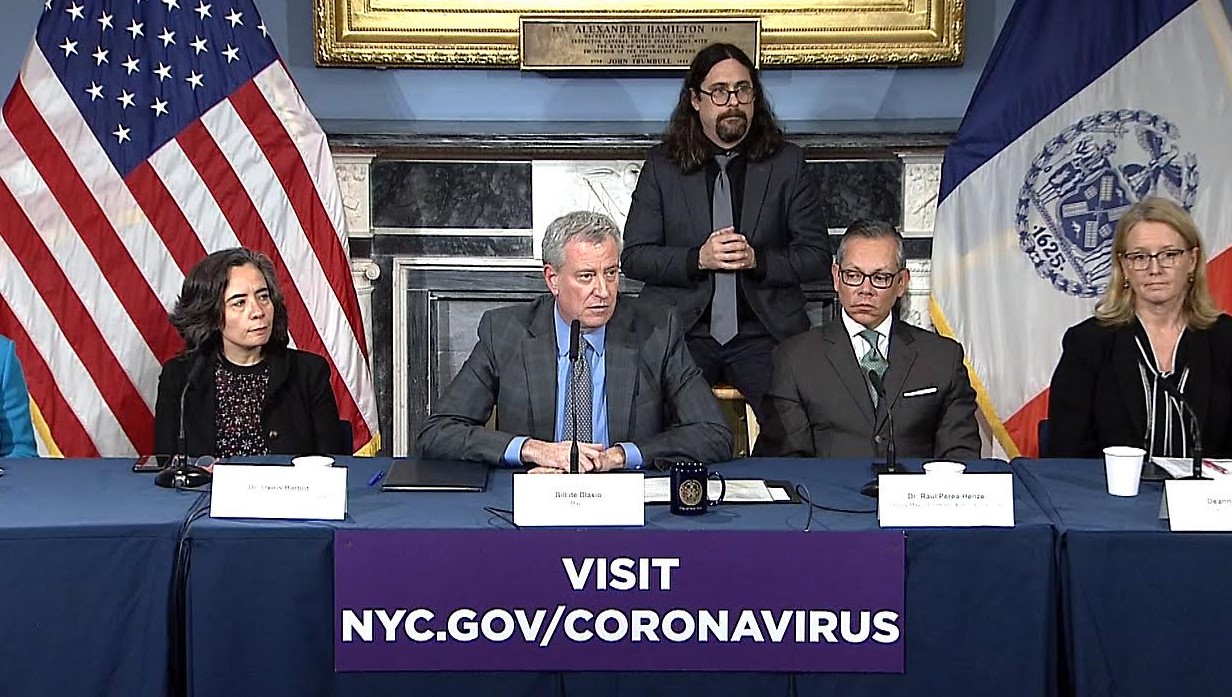By: Ilana Siyance
On Thursday March 12th, Mayor Bill de Blasio made a momentous announcement declaring NYC to be in a State of Emergency over the novel and deadly Coronavirus. “It’s going to get a lot worse before it gets better,” the mayor warned during a City Hall news conference. As reported by the NY Post, he predicted that there will be close to 1,000 confirmed cases by next week.
On Thursday, the number of confirmed cases of the coronavirus leaped to 95, up from 42 cases just a day ago on Wednesday. “These overall numbers are striking and troubling,” said de Blasio. 1,784 people are under voluntary home isolation. Those under mandatory quarantine receive daily calls and twice weekly, unannounced visits by the Department of Health and Mental Hygiene. Upon identification, all individuals under voluntary home isolation will receive calls and texts with information and reminders to call a doctor or DOHMH if they feel sick or develop symptoms, such as fever and cough or shortness of breath.
The mayor said the crisis is expected to last at least six months, with more time added for recovery. Despite the bleak report, the mayor said that NYC’s public schools will remain open for now notwithstanding the outbreak. Still, all extracurricular activities as well as parent-teacher conferences are being canceled or moved online. The mayor has authorized 10 percent of the city’s staff to work online, and has shifted hours away from peak times for another 20 percent of the municipal workforce.
“This will not be over soon. It’s going to be a long, tough battle,” warned de Blasio. Mayor de Blasio also backed the decision by Gov. Andrew Cuomo to shutter all locations with legal occupancy of over 500 people, and to cut the occupancy of smaller places in half. De Blasio said he “won’t be surprised” if the decision forces companies to close down, but said, “These are the rules we will enforce from now on.” “I can assure you, none of us wanted to take this action,” de Blasio added bleakly. “But it is the point where it’s necessary.”
The decision will officially shutter concerts and shows in multiple venues including Madison Square Gardens and other cultural institutions.
Existing and future standalone events with attendance exceeding over 500 persons, including parades, sports events, performances, races, and rallies are canceled until further notice. Programming will also be canceled at indoor venues with consistent seating capacity over 500. Establishments with a capacity of 500 people or less, including concert venues, theatres, museums, department stores and religious institutions are required to maintain an occupancy level at or below 50% of their legal capacity to ensure maximum social distancing.
With the emergency order in effect, the City will examine its Census outreach work, and recommend the suspension of door-to-door canvassing for upcoming local special elections.
Already, on Tuesday one usher who worked at two theaters on Broadway tested positive for the coronavirus. The mayor had taken his time in rolling out the moratorium on large events and public gatherings, despite advice from officials with the city’s Department of Health and Mental Hygiene who have been pushing for the measure for days now. “The only way to dampen an epidemic when it gets to community spread is to practice social distancing,” said Dr. Mary Bassett, the mayor’s former health commissioner who now teaches at Harvard. “That’s a hard decision that’s going to have to be made. I would say it should be made sooner versus later like right now,” she said.
“We’re making tough choices that we know carry very real consequences for New Yorkers’ health, but also their livelihoods. To curb this pandemic, we need greater social distancing. Each of us needs to change our lives to protect the people most act risk. We’re therefore cancelling large gatherings and implementing strict reductions on smaller ones. This isn’t the first set of restrictions we’ve handed down and it will not be the last. As we learn more about COVID-19 and how it spreads, we’ll continue taking steps to keep New Yorkers safe,” said DeBlasio.
To effectively implement social distancing, the Department of Education will cancel or offer web-based alternatives of extracurricular activities such as athletic games and practices, school-wide assemblies, parent teacher conferences (available by phone), school field trips, school plays, and recitals. After school programs, including DYCD programs, currently remain unaffected, with the exception of some extended use permits that serve primarily adults.
The Department of Social Services will activate the City’s emergency food contracts in coordination with other City agencies as needed.
For eviction assistance, please call 311 or Infoline at 718-557-1399 to be referred to one of HRA’s Homebase offices.
If you are facing eviction at Housing Court you may be able to access free legal representation through HRA’s Office of Civil Justice. Please Call 311 for more information.
Individuals seeking emergency Cash Assistance to cover rent or utility arrears can visit any one of HRA’s Job Centers to apply for these benefits also known as “one shot deals”. Additionally, individuals with an active Cash Assistance case can also visit www.nyc.gov/ACCESSHRA to apply for a one shot deal online. Eligibility will be determined based on factors including available income and resources. Call 311 to find your local Job Center.
Please go to ACCESS/HRA at www.nyc.gov/ACCESSHRA to see if you qualify for SNAP/food stamps.
If you need emergency assistance with food, call 311 to find your local pantry or kitchen – note there is no income guideline for emergency food.
Please go to https://info.nystateofhealth.ny.gov/ or call the NYS State of Health at 1-855-355-5777 to see if you can qualify for Medicaid or other free and low cost health insurance.
Over 121,000 New Yorkers have signed up to receive text alerts on COVID-19. To get regular updates on the latest developments with coronavirus in New York City text COVID to 692-692. You will receive regular SMS texts with the latest news and developments. If you have any questions on finding medical care call 311.
It seems New Yorkers have been bracing for the official decision. Even as of Tuesday afternoon, a Post photographer took pictures of the usually bustling Times Square subway station, showing it was eerily close to empty. It seems many commuters were heeding advice by the mayor to stay off the subways during peak rush hour. “If you’re going to have to use subways, use it on off-hours. To the maximum extent possible avoid the rush hour,” de Blasio had warned on Tuesday. Of course, not all straphangers had the option of staying away from the subways.
On Tuesday morning, the Post reported there were four homeless people asleep on the floors and seats of a D train making it look like a hostel. “I know homeless people don’t want to be in a shelter, but they need to find a place for them out of the subways until the virus blows over. It makes me nervous when I think about it,” said one passenger who identified herself as Val.
Similar restrictions on large gatherings have been set by Gov. Cuomo in the state of New York, whereas of Wednesday there were 212 confirmed cases of the notorious coronavirus.
In Long Island, Nassau County now has 28 cases, and Suffolk County and Rockland county each have six confirmed cases. The governor urged calm. “The facts here do not justify the amount of fear,” said Cuomo Wednesday. “The facts here actually reduced the anxiety. We have 212 cases in the state of New York. [Just] 32 are hospitalized.”
Within the state of NY, the hardest-hit county is still Westchester, which had 13 new cases Wednesday for a whopping total of 121. As reported by the Post, beginning on Thursday, the National Guard has been enforcing a one-mile-radius “containment area” in New Rochelle, imposing a two-week closure of large gatherings there, including schools and places of worship.





